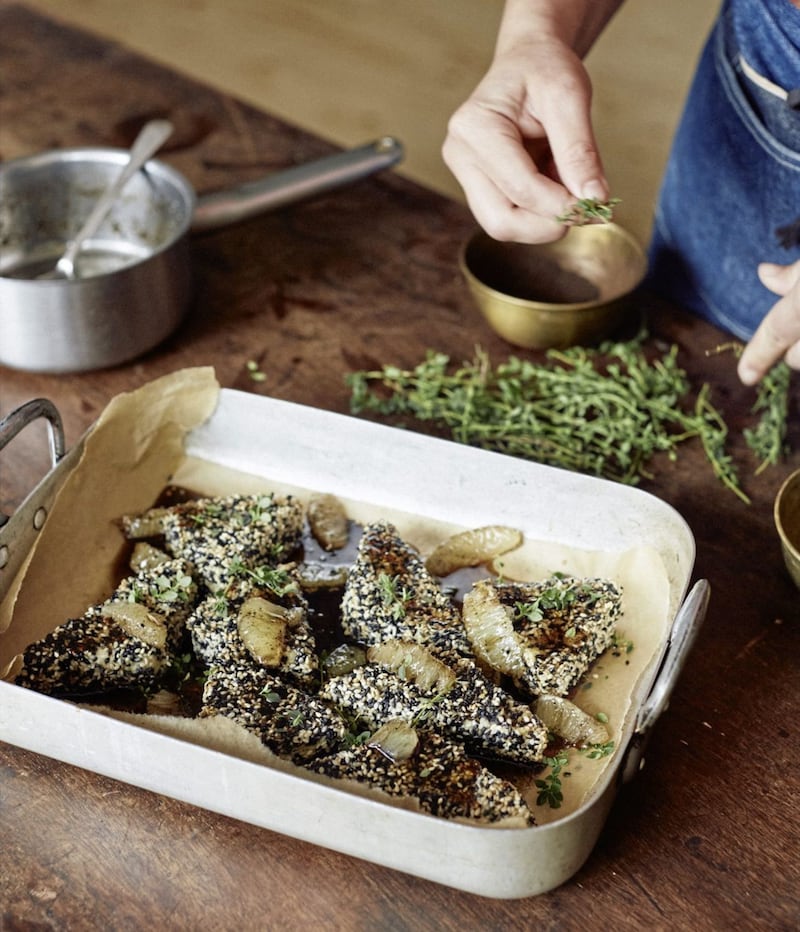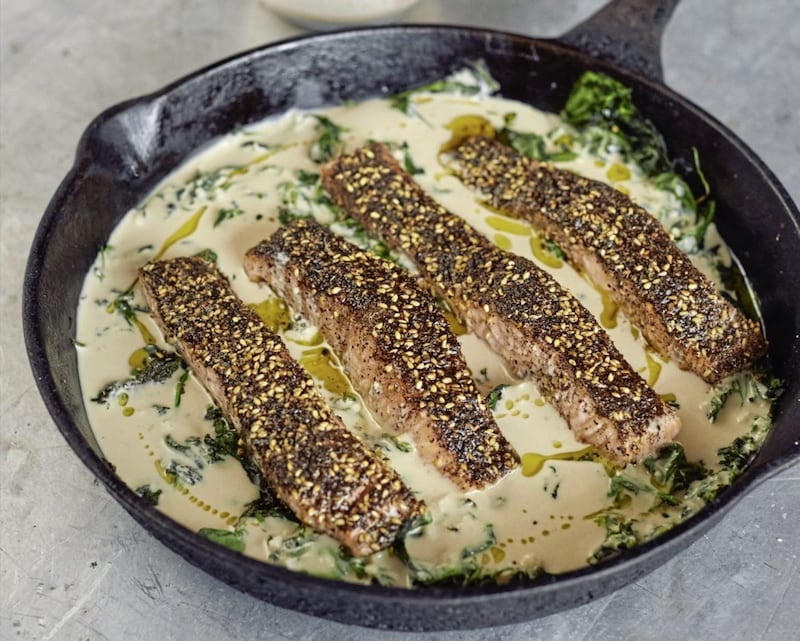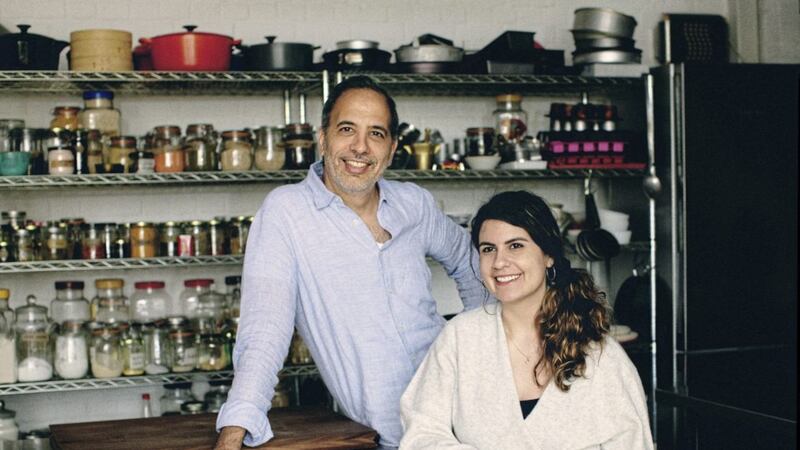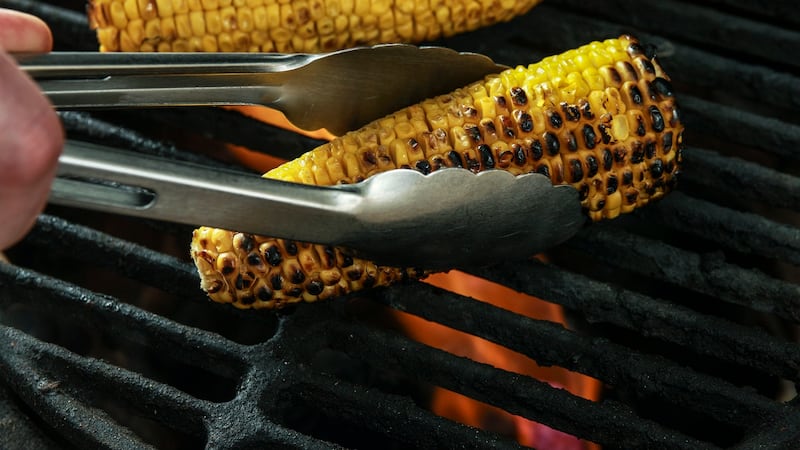GIVEN the time it takes to research, compile and publish a recipe book, most of the titles hitting book shops right now started life long before the pandemic began. Shelf Love is different.
The first Ottolenghi Test Kitchen cookbook – co-authored by founder Yotam Ottolenghi and head of the OTK (as it’s known) Noor Murad, with recipe contributions from other team members – was conceived during the UK’s first lockdown, as an ode to ‘that one shelf in the back of your pantry’ (or fridge or freezer) where all kinds of pulses, grains, condiments, spices and other culinary surprises lie in wait.
“Noor and I were having these conversations… and it became really clear that something really quite dramatic is happening,” Ottolenghi says, thinking back to spring 2020.
“People were really excited about the subject that we were were covering in this book, which is kind of rediscovering their kitchens, rediscovering old simple ingredients that you can get in abundance.”
View this post on InstagramA post shared by Yotam Ottolenghi (@ottolenghi)
The Israeli-born chef, writer and restauranteur was unwell with Covid when the OTK – the recipe testing and writing hub, located under a railway arch in London’s Camden – was forced to close in the March.
“It wasn’t as bad as other people got it, but it was bad enough for me not to be able to do anything for two or three weeks. Luckily, I didn’t need to go to hospital… I felt very sorry for myself for that period, it was was pretty tough,” he recalls of being struck with the virus.
With their founder out of action, Murad and the rest of the team shuttered the kitchen, and went their separate ways to wait out lockdown.
“But we stayed very connected with, you know, the beauty of social media and Zoom calls,” says Murad, who returned to her native Bahrain (she has dual nationality, thanks to an English mother). That was when cookbook inspiration struck.
View this post on InstagramA post shared by Noor Murad ??? ???? (@noorishbynoor)
“Raiding,” is what Shelf Love is all about, she continues. “Emptying out your shelves, using up what you have, being quite creative and playful with recipes, replacing certain spices with others based on what you have at home.”
As any Ottolenghi fan would expect, Middle Eastern flavours loom large, as do vegetarian dishes, like chickpeas cacio e pepe and sweet potato shakshuka, as well as carnivorous delights like sesame-crusted feta and black lime beef skewers.
View this post on InstagramA post shared by Yotam Ottolenghi (@ottolenghi)
What, you might ask, is a black lime? Murad says she wanted to put the dried citrus fruit “on a pedestal” in the new book: “They’ve got a quite sour, bitter flavour – in the best way. I really want people to feel familiar with black limes, to the point that they will always have a bag or a jar in their cupboards.”
Ottolenghi agrees: “If you put [a black lime] into a stew without doing anything to it, it will give it a really, really different twist. It changes the whole flavour profile.”
The 52-year-old, who moved to London in 1997 to study pastry making at Le Cordon Bleu, says he’s noticed a “real shift” in attitudes towards food since he arrived, in terms of the “knowledge of ingredients, that desire to test, try new things and enjoy new ways of cooking. You go to the supermarket, the most popular thing in a tub is humous – it’s not coleslaw.”
View this post on InstagramA post shared by Noor Murad ??? ???? (@noorishbynoor)
The chef himself is partly responsible for the phenomenal popularity of Middle Eastern cuisine in the UK. After founding his eponymous delicatessen in Notting Hill in 2002 – which attracted a cult following and introduced customers to ingredients like za’atar, tahini and pomegranate molasses – the Test Kitchen opened the same year, followed by two more delis, two Ottolenghi eateries as well as the trendy Rovi and Nopi restaurants.
What was it like being a business owner during the pandemic, when restaurants were forced to close for months at a time and thousands of establishments had to shut their doors for good?
“It was very traumatic, very difficult, very painful,” Ottolenghi says. “I never thought it would come to that moment. But now, I’m glad to say that we are almost back to normal. Luckily, we haven’t had to shut anything and the business is doing well.”
Those dark days gave him a renewed sense of gratitude: “I think that’s the kind of trauma that stays with you. Everybody experienced that with the pandemic, but in their own worlds and in their own ways. For me, it’s just, I don’t take anything for granted anymore.”
And, looking on the bright side, both chefs agree that lockdown gave them one unexpected gift – more time with loved ones.
Murad says: “My whole family lives in Bahrain. It had been five years that I’d been away, so to be able to spend that time with them, which I never thought I would get again, was really quite priceless.”
Ottolenghi admits the “sophistication of my palate [went] down dramatically during that period” due to “a lot of stodge” eaten while catering to Max, eight, and Flynn, six, his sons with husband Karl.
“For me, being at home with my family was just lovely. I mean, the downside is the homeschooling, but I think that everybody struggled with homeschooling.
“But the upside is so nice, because we really got to spend quality time getting to know each other, doing things that we haven’t done before – nature walks and things like that. And it’s just been really precious.”
Ottolenghi Test Kitchen: Shelf Love by Noor Murad and Yotam Ottolenghi, photography by Elena Heatherwick, is pubished by Ebury Press, priced £25. Below are three recipes for you to try at home...
Sweet potato shakshuka with sriracha butter and pickled onions recipe
(Serves 4)
1kg sweet potatoes, skin on and scrubbed clean
1 small red onion, thinly sliced into rounds
2tbsp lemon juice
3tbsp olive oil
150g mature cheddar, roughly grated
3 garlic cloves, crushed
1tsp cumin seeds, roughly crushed with a pestle and mortar
8 medium eggs
25g unsalted butter
¾tbsp sriracha
2tbsp picked fresh coriander leaves, with some stem attached
Salt and black pepper
Method:
Preheat the oven to 200°C fan. Poke the sweet potatoes all over with a fork (about eight to 10 times) and place them on a medium, parchment-lined baking tray. Bake for 45–50 minutes, or until cooked through and softened. Set aside to cool and turn the oven temperature down to 180°C fan. Meanwhile, in a small bowl mix together the onion, one tablespoon of lemon juice and a pinch of salt and set aside to pickle. Remove the cooked potato skins and tear them into roughly 4cm pieces. Transfer the potato flesh to a large bowl and set aside. Place the skins back on the baking tray and toss with one tablespoon of oil, a quarter teaspoon of salt and a good grind of pepper. Bake for eight minutes, or until nicely coloured and starting to crisp up. Set aside to cool and crisp up further. Use a fork to mash the potato flesh until smooth, then add the cheddar, garlic, cumin, another tablespoon of oil, the remaining tablespoon of lemon juice, one teaspoon of salt and a generous grind of pepper, and mix to combine. Put the remaining tablespoon of oil into a large frying pan, for which you have a lid, and swirl around to coat the bottom. Spoon the mashed potato mixture into the pan, using your spoon to distribute it evenly. Place on a medium-high heat and leave to cook for about seven minutes, for the bottom to start to colour. Turn the heat down to medium and use a spoon to make eight wells in the potato mixture, breaking an egg into each. Sprinkle lightly with salt and pepper, cover with the lid and cook for four to five minutes, rotating the pan, or until the whites are set and the yolks are still runny. While the eggs are cooking, put the butter and sriracha into a small saucepan on a medium heat and cook until the butter has melted, whisking constantly to emulsify. Remove the mixture from the heat before it starts to bubble – you don’t want it to split.
When ready, spoon the sriracha butter all over the eggs, then top with a good handful of the crispy potato skins, half the pickled onion and all the picked coriander leaves. Serve right away, with the rest of the potato skins and pickled onion to eat alongside.
Sesame-crusted feta with black lime honey syrup recipe

(Serves 8)
2 blocks of Greek feta (360g), each cut into 4 triangles (8 triangles in total)
35g rice flour (or plain flour if gluten-free flour not needed)
1 large egg, well beaten
100g mixed black and white sesame seeds, lightly toasted
2tbsp olive oil
½tbsp picked lemon thyme leaves, or regular thyme leaves
For the syrup:
120g runny honey
1tsp ground black lime (optional)
3 lemons: 1 juiced to get 1tbsp and the other 2 left whole
Method:
Line a shallow baking dish (or baking tray with a slight lip), about 30cm x 20cm in size, with baking parchment. Pat dry the feta pieces, then dip each piece in the flour, gently shaking off the excess. Coat in the egg, followed by the sesame seeds, making sure the feta pieces are completely coated. Transfer each piece to your prepared dish and refrigerate for at least 30 minutes, or longer if time allows. Preheat the oven to 220°C fan. Drizzle the coated feta pieces with the oil and bake from cold, for 18 minutes, very gently flipping the pieces over halfway, or until golden and warmed through. While the feta is baking, put the honey and black lime, if using, into a small saucepan on a medium-high heat. Once it starts to bubble, turn the heat to medium and cook, stirring occasionally, until it turns a deep amber caramel, about six to seven minutes. Take off the heat and stir in the lemon juice. Set aside to cool for five minutes. Use a small, sharp knife to peel and segment the remaining two lemons and stir the segments into the cooled honey mixture. When ready, pour the lemon syrup directly over the feta in the baking dish, sprinkle with the thyme and serve at once, straight from the dish.
Za’atar salmon and tahini recipe

(Serves 4)
4 salmon fillets (600g), skin on and pin bones removed
2tbsp za’atar
2tsp sumac, plus ½tsp extra for sprinkling
60ml olive oil
250g baby spinach
90g tahini
3 garlic cloves, crushed
3½tbsp lemon juice
1½tbsp roughly chopped
Coriander leaves
Salt and black pepper
Method:
Preheat the oven to 220°C fan. Pat dry the salmon and sprinkle with salt and pepper. In a small bowl, combine the za’atar and sumac, then sprinkle this all over the top of the salmon to create a crust. Place a large ovenproof sauté pan on a medium-high heat and add a tablespoon of oil. Once hot, add the spinach and a pinch each of salt and pepper and cook for two to three minutes, until just wilted. Top with the salmon, skin side down, and drizzle the top of the fish with two tablespoons of oil. Bake for five minutes. Meanwhile, in a small bowl whisk together the tahini, garlic, two-and-a-half tablespoons of lemon juice, a good pinch of salt and 100ml of water until smooth and quite runny. When ready, remove the pan from the oven and pour the tahini all around the salmon (but not on the fish at all). Bake for another five minutes, or until the fish is cooked through and the tahini is bubbling. Spoon over the remaining tablespoon each of lemon juice and oil and top with the coriander and extra sumac.



